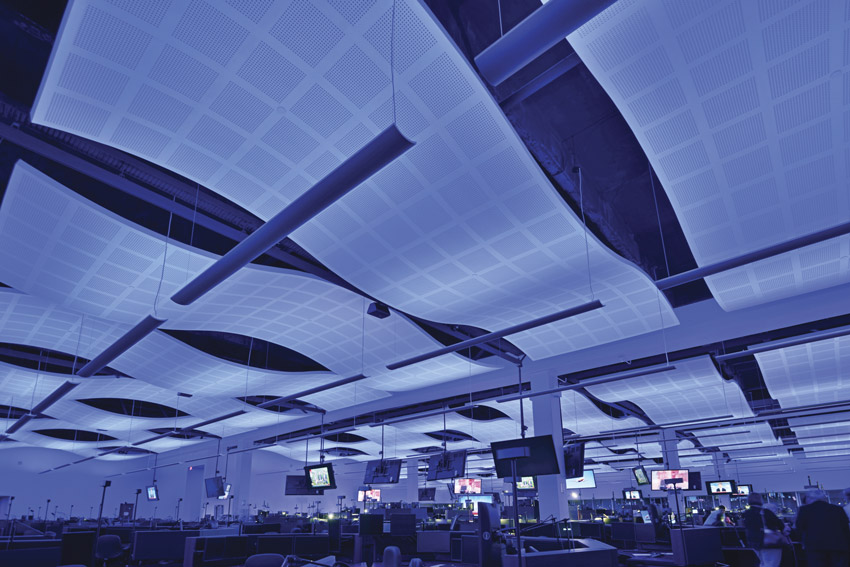The Evolving Workplace Environment
Creating spaces that respond to changing needs
![]() Continuing Education
Continuing Education
Use the following learning objectives to focus your study while reading this month’s Continuing Education article.
Learning Objectives - After reading this article, you will be able to:
- Identify and recognize the significance of acoustics as part of the beneficial indoor environmental design criteria for both collaborative and individual workspaces.
- Assess the performance and aesthetic aspects of wall and floor surfaces as they relate to durability, safety, and interior design flexibility.
- Explain the various means to accommodate a mobile workforce that looks for readily accessible, available, convenient power and data sources wherever they may work.
- Determine ways to incorporate better design principles into restroom design for sanitation, health, and overall better workplace design.
The places where people work have always needed to accommodate not only the type of work being done but also the organizational or management systems surrounding that work. Agrarian workplaces were necessarily tied to the land being farmed and often caused people to be spread out across a broad area to operate independently. Industrialization brought centralization of the workforce around manufacturing facilities but also required work time synchronization in order for the facility to function. The rise of the “knowledge worker” as first coined by business writer Peter Drucker in 1959 identified the predominance of information- and service-based work shifting work products from “things” to information and services. Our current, interconnected, 24/7 world breaks through these previous restrictions of location, time, and products, offering new opportunities but also bringing challenges of productively managing a diversely structured workforce. In order for architects to design effective workplace environments then, we must be aware of and responsive to the changing needs of workers and management in the context of the evolving workplace. In this course, we will look at some of the drivers of change and some examples of interior building design strategies that can foster exemplary workplace environments.
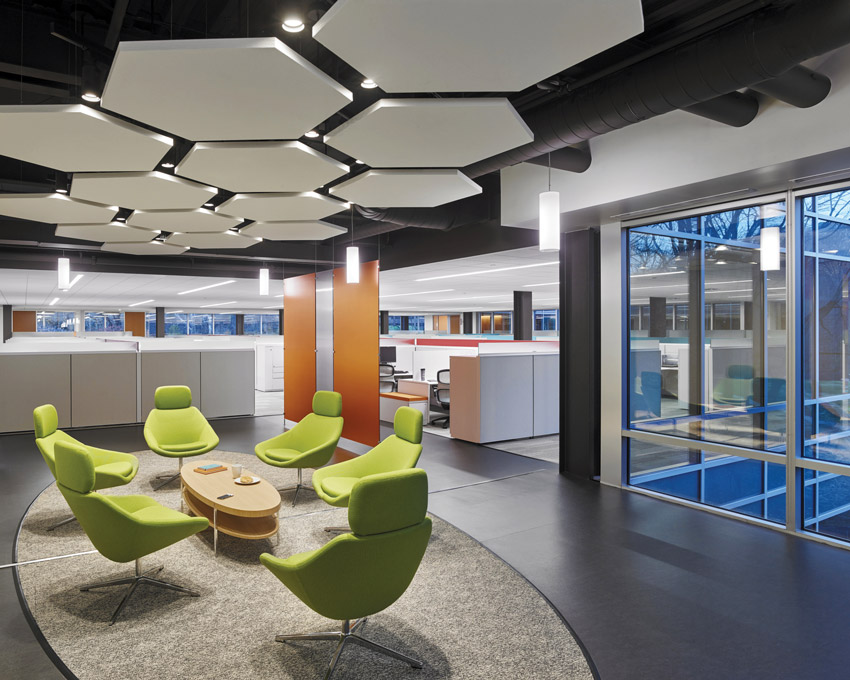
Photo courtesy of CertainTeed Ceilings/Photo: © Jeffrey Totaro, 2015
Workplace environments have changed notably from the hierarchical, isolated layouts of the 20th century to more diverse settings that contain spaces for collaboration, individual work, socialization, and learning.
Matching Workspaces to Work
Most workplace organizations identify their two largest expenses first as labor costs, and second as real estate. In order to be economically sustainable and/or profitable then, any given organization needs to balance and optimize both of these. The design question usually becomes how best to create an appropriately sized and properly balanced workspace that allows individual workers to be fully engaged (i.e., productive) and helps the organization to thrive.
One of the first steps in designing a relevant workplace for a contemporary workforce is to realize that some of the 20th century design approaches were based on modes of working that have become outdated. Manufacturing and industrial facilities often relied on hierarchical organizations with work groups set up in individual “silos” that were quite immobile. Commonly, separate business units occupied separate buildings, where management had closed offices around the perimeter and the remaining staff had cubicles with little or no access to daylight. Typically, everyone was tethered to a desk focused on individual work tasks, and interaction across divisions was minimal. While that model worked well for its time and for certain large organizations such as the military, it should no longer be viewed as the starting point today. Such organizational and physical models can now actually work against contemporary goals of employee engagement and knowledge development, which are universally accepted as the current engines of economic success.

Image courtesy of CertainTeed Ceilings
The U.S. General Services Administration (GSA) found that workers who moved from old workspaces to new ones designed to accommodate their work style were generally more satisfied by most measures except for acoustical quality.
Individual Work versus Collaboration
One of the biggest changes in recent times is the shift from individual work to teamwork or collaboration. The knowledge-based nature and complexity of the work of many organizations has required more input from different people to be effective and successful. In fact, data from a survey of 600 corporate executives conducted by the Gartner Group found that the percentage of workers’ product being dependent on group input increased from about 25 percent in the year 2000 to 60 percent in the year 2010. Further, while the traditional mode was for employees to work on a single project or initiative for a long period of time, today it is much more common that everyone is working on multiple projects simultaneously, requiring multiple collaborations.
Given this rather swift change in the nature of work, it is not surprising that a Steelcase/CoreNet Global survey found that workspaces and work activities are out of alignment in many cases. In this survey, more than 40 percent of respondents stated that their workplace “was split 80/20, with 80 percent of space supporting individual work and 20 percent supporting collaborative work. Yet the number of employees whose actual work process followed that same 80/20 individual/collaborative split was only 8 percent.” Clearly, the work processes have changed faster than their environments.
With the trends on the changing workplace cited above in mind, the question becomes: What are some of the appropriate design responses? We will take a look at several answers in the following sections.
Acoustics
Some organizations and design professionals have been aware of these issues and pushed forward rapidly to create collaboration-friendly, open-plan office environments. Unfortunately, some workers have made dramatic and sometimes counter-productive moves from isolated workspaces to environments that create nonstop distraction. In response to these dramatic changes in the work environment, the U.S. General Services Administration (GSA) launched an initiative called WorkPlace 20•20. Its goal was to develop tools and methodologies to help federal agencies realign their work settings to support new organizational structures, work styles, and technologies. Seven years later, it conducted an evaluation of 40 projects in 11 agencies that had been delivered in that time. Among its findings, one factor stood out as a challenge: namely, acoustic conditions. More than half of occupants surveyed remained dissatisfied with noise levels and speech privacy in their new environments.
Based on this and other findings, it is becoming clear that a successful workplace environment design needs to address several conditions, including:
- Spaces to accommodate different work modes: Modern workplaces need to be designed to include both appropriately sized collaborative work paces and quiet workspaces for individuals to engage in focused work. In terms of collaborative spaces, homogeneity in the sense of several large conference rooms is not helpful. Rather, spaces that can accommodate five to eight people are seen as ideal for productive collaboration. There is also a common need for one-on-one meetings and any number of other configurations in addition to one or two full-scale conference-style rooms. Private, individual spaces can include a quiet setting for phone calls, virtual meetings, or intense, focused work. All of these need to be considered based on the nature of the work processes of the people there.
- Spaces for socialization and learning: Beyond pure workspaces, there is a need for other types of spaces in a workplace environment that help support some of the human needs of the people there. Places to socialize, for instance, allow for interactions that build trust and solidify relationships, including talking, laughing, celebrating, and networking. Similarly, places for individual or group-oriented learning help with career advancement and commonality of a knowledge base.
- Locating spaces: Properly locating the various spaces in relation to each other helps the overall workplace environment just as well urban planning helps an overall town or city. Muffy Byrne, project director from Jacobs, maintains that when it comes to ensuring productivity, the planning concept is a key driver. She finds success comes from following sound principles of space allocation, positioning, the ratio of open to closed space, and the location of different spaces in relation to fixed elements in a facility, such as stairwells or restrooms. It can also facilitate a variety of open, collaborative areas along circulation areas for impromptu meetings and conversations. Further, socialization hubs such as break rooms or eating areas can double as a town hall or learning center with the characteristic of providing friendly gathering spaces.
With these conditions in mind, it is critical to address the acoustics of each of these spaces. In collaborative or other group spaces, there is a need to ensure that the sound quality is appropriate but also contained within those spaces. That can be achieved in part by location but also by the way the spaces are treated acoustically. In private or individual spaces, there is a need to prevent unwanted sound (i.e., noise) from entering the space so as to avoid distractions that reduce productivity and engagement. In most office environments, the number-one way to manage sound is through good acoustic ceilings design. Not only is the ceiling the largest surface area available and located in close proximity to users, but if left untreated, it can become a vast reflector of sounds.
While there may be a design tendency to use a single ceiling solution across all of the different spaces, the fact is that different ceiling products are likely called for to provide the acoustic needs of different spaces. Open office spaces might use ceiling products that look identical but may have very different properties. Fiberglass tiles with a very high noise reduction coefficient (NRC) of 0.95 can maximize absorption of background noise. However, in areas below mechanical equipment in a plenum, composite ceiling systems can perform a dual acoustic function, with a fiberglass face absorbing sound while a mineral fiber backer blocks the mechanical noise. The matching surfaces might also support daylighting and energy-use goals with high percentages of light reflectance. This strategy is essentially a “targeted acoustics” approach that can be employed to create an acoustically comfortable space without compromising visual impact or budget. Manufacturers tend to focus on providing architects with choices so they can select the right ceiling solution for each space. This includes all aspects of the ceiling products: acoustic performance, aesthetics appeal, and affordability.
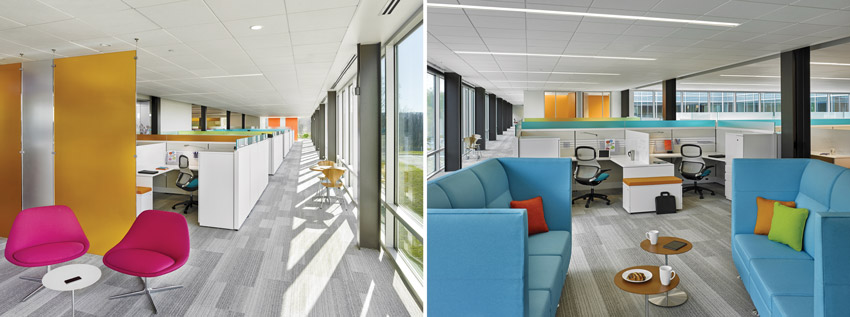
Photos courtesy of CertainTeed Ceilings/Photo: © Jeffrey Totaro, 2015
Ceiling systems can play a dramatic role in controlling acoustic conditions in modern workplace environments that contain both collaborative and individual workspaces.
Wall Surfaces
With workplaces becoming more diverse and in many cases more open and fluid in their layout, walls become significant definers of spaces. The ways those walls are finished speak to the nature of the work environment not only in terms of the functional durability and suitability for a work setting, but also in terms of the impact that they have on the design and the perceptions of those who work in the indoor environment.
How indoor environments are perceived may have as much to do with generational differences than anything else. For the first time in history, it has been noted that our workforce comprises four generations, and each one has a different approach to work and the workplace environment. For example, the Bureau of Labor Statistics reports that workers who have been in the workforce for 10 to 20 years have changed jobs an average of 10.5 times compared to workers who have been in the workforce for more than 30 years averaging fewer than six job changes. Other surveys indicate the significance of health-care coverage in keeping or leaving a job. Overall, the old workplace models based on large, private, windowed offices reserved for people solely on the basis of rank and seniority, or the concept of working in the same place every day, have little appeal to modern workers who embrace technology to control the possibilities for when, why, how, and with whom they work. In light of these findings, it is not unreasonable to assume that new and different approaches to the interior design of a space are the norm for younger workers too.
One of the ways to take a creative approach to durable interior wall surfaces is to consider the use of wall panels that can be configured in standard or custom sizes, shapes, and finishes. Such panels can be applied to partitions and walls in creative ways. Commonly constructed of a 3/8-inch substrate laminated with PVC-free rigid sheet, panels of this type can be specified in standard sizes and a variety of thicknesses with reveal options. They can create bold and elegant interiors featuring wrapped square-edge panels, beveled-edge panels, and, for unfinished-edge panels, picture frame and thin trims. Such wall panels also offer dimensional flexibility for custom shapes and unique configurations. Finish options include a selection of solid colors and simulated woodgrain patterns. Photography, branding, and other graphics also can be incorporated across a series of panels.
In terms of installation, flexibility and ease are typical. Historically, the installation of demountable wall panel systems, used mostly in health care, education, and office buildings, was challenged by cumbersome clips and brackets. New offerings that use specifically designed hardware and accessories reduce installation time by at least 50 percent and allow for easy panel removal for routine maintenance and interior updates. Further, panels with wrapped edges can also be spliced in the field, avoiding the necessity for trims and exact panel dimensions.
How do such panels hold up over time? Manufacturers of such panels pride themselves on their history of interior wall protection with projects in place and performing well for decades. Some provide a wide range of wall protection products, including rigid sheet, handrails, crash rails, corner guards, and door and frame protection in a variety of materials based on the stress a wall needs to sustain. They bring that history and expertise to the wall panel design with options for both surface-mounted and recess-mounted applications. Overall, it is safe to say that these panels are more durable than laminate or stained wood applied to a wall and are produced to keep walls in workplaces beautiful and damage free years after installation.
Some manufacturers seek to share their extensive product knowledge by working closely with architects and designers on complex design issues, including making the best product choice for each application. Because the nature of the wall panel system is to provide protection of the wall beneath while offering a variety of aesthetic options, it is easy to work with such a manufacturer to create a space that complements a building’s design while remaining functional. Manufacturers can provide assistance from conceptual design to post-installation services for field-verified dimensions, technical support, product mockups, and sample coordination. They often work with architects and designers to help them select the product best suited for their building type considering factors that affect their building.
Amy DeVore, business development manager for Construction Specialties, comments on this role that manufacturers can play in providing new design options. “We redesigned the wall panel system because we recognized a need to provide solutions that weren’t available in the market. With rapidly changing trends, it is important to create products that solve frequent problems related to design and installation. As a result, we have a simplified wall panel system that we can confidently offer to design professionals knowing it will significantly add value by reducing installation time and expand the aesthetic options.”
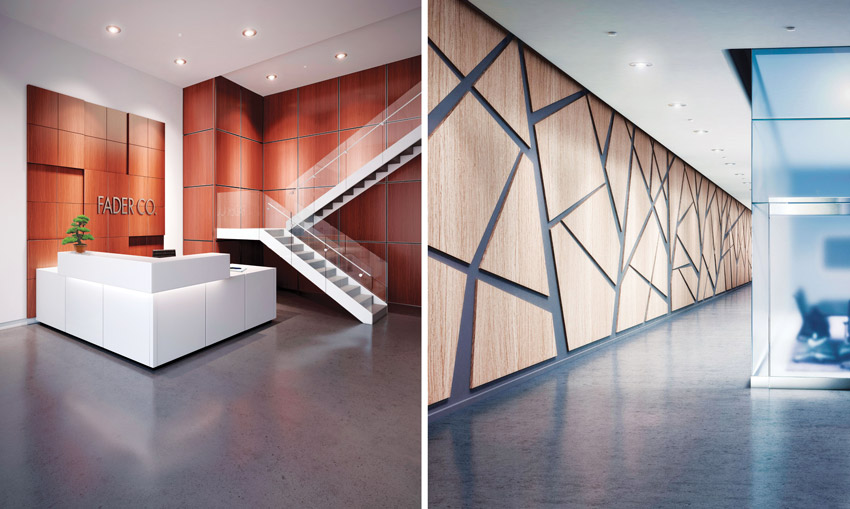
Photos courtesy of Construction Specialties
Wall panel systems are available in solid and simulated woodgrain finishes that can enhance workspace environments in traditional or creative ways to create bold designs embraced by the people in the building.
Technology and Mobility
One of the more dramatic changes in the way knowledge workers spend their time comes from the advancements in computer technology. Before the 1990s, virtually all organizations relied on paper documentation and filing systems coupled with physical communication systems, such as U.S. mail and telephone calls. Today, virtually all organizations rely on computerized work processes that link people instantly to electronic documentation and communications. One of the results of this improved technology is the ability for workers to be more mobile, meaning they can be quite engaged and productive outside of the office. Connecting electronically from remote locations allows those jobs that require face-to-face contact with people outside of the organization to be highly productive wherever they are. It also means that employers can be flexible about allowing employees to work from home or other locations.
With people spending less time in the office, though, it begs the question of why dedicate so much real estate space for them? The GSA has developed a white paper titled “Leveraging Mobility, Managing Place,” which summarizes some research on finding the right balance between mobile, electronically connected workers and a centralized work building.1 It indicate that creating a mobile workforce has benefits for the organization and the people but also has implications for the design of workspaces. Specifically, it finds that since people don’t require formal, full-time workspaces, mobility can actually support higher space utilization through shared arrangements or other means. It also finds that it is good for the natural environment by reducing the carbon footprint of the workforce in many cases. Looking toward the emerging design trend, the GSA sees it creating denser workstation areas, more varied space types, and reduced real estate as the percentage of mobile workers increases. A separate study by CoreNet Global reported that between 2010 and 2012, the average workplace dropped from 225 square feet per person to 176 square feet. It predicts that this may drop to as low as 100 square feet for many facilities in 2017.
Another aspect of computer technology is the ability to work asynchronously, meaning teams can communicate or work together not only in different places but also at different times. In a GSA publication titled Workplace Matters, data provided by the Gartner Group leads it to indicate that “working with others while in different times and different places will become the dominant work style of the future, replacing noninteractive work, which was the dominant workstyle of the past.” Commonly, it used to be routinely assumed that physical meetings where everyone was in the same place at the same time was the only way to collaborate. With the increasingly available computerized communication technology, meeting at the same time but in different places has become quite routine using video conferencing, audio teleconferences, or similar means. Further, since most types of electronic communication can be filed and accessed after the fact, asynchronous meetings and communications are also very common. Sending emails or creating online shared documents that are read and responded to later are simple versions of this. Recorded meetings are another version, where webcasts or podcasts can be retrieved to allow people to collaborate by gaining the knowledge of the meeting and then responding on their own schedule to interact with the rest of the group. Everyone showing up at the same place and same time is no longer required for full engagement and productivity.
What does this technological mobility and connectivity mean for design? As the workplace evolves, one constant remains: the need for power and data connections to supply our desktop and mobile devices in all of those different places and times. Even in a wireless world, mobile devices still need power and a data connection. Such power and data connections accommodate the flexibility of time and location of workers by enabling the connectivity that is required to function in the digital landscape. This could take the form of standard 120-V outlets or USB ports, or even a wired Internet connection. Most significantly, this convenience is no longer only true of offices but also at home, in hotels, retail locations, airports, and all of the other places that mobile workers can use to connect, be productive, and remain fully engaged. Designers are being asked to include such ports not only in walls at these locations but also into built-in and even movable furniture.
Recognizing this trend, clever and convenient power grommet solutions have been developed by manufacturers that are specifically intended to be integrated into furniture to help create new working environments. An extensive array of such power grommets for the modern workspace has become available and can be readily selected and specified. Because they are typically complete and UL listed, just like electrical outlets, they can be easily incorporated in a code-compliant and durable manner. Such power grommets have been used in diverse locations ranging from community workstations and shared workspaces to nontraditional workspaces like hotel lobbies and bedside nightstands. Power grommets can be hardwired by an electrician or they can be made with a standard plug that can be inserted into a wall outlet. They also come in a variety of forms, including flip-ups, pop-ups, recessed, and edge mount versions, lending their mixed use versatility to any application.
A complementary but often necessary component to creating this connectivity is wire management. Wires and cables are best handled in channels or hardware that keep them safely run along the back edge of a work surface or some similar out-of-the-way place. This keeps things working smoothly and helps eliminate the potential of unsightly conditions. It also helps avoid accidental snags or pullouts of the wire or plugs in receptacles. Wire managers are available that include products for floors, under desks, behind desks, and a variety of clips, straps, and loops to help channel cables neatly and out of sight.
Manufacturers of power grommets and wire management systems have seen and responded to the changes in the working environment, even helping to move them forward in some cases. Incorporating power, data, and wiring in mobile work locations ultimately has the capability to turn any space into a potential workspace and takes emphasis away from the traditional work desk. Since power can sometimes be in short supply in nontraditional workspaces, the addition of such features helps more people work remotely and be mobile. Billy Peele, marketing manager at Doug Mockett & Company, says, “With the evolving workplace in mind, convenient power solutions to accommodate workflow are now more important than ever.” Anna Orfanides, founder and CEO of Anna O Design, Boston, agrees. She used flip-up power grommets in an office complex common area on a waterfall table design with lime plaster surface finish, and the multiple power points helped turn this shared space into not only a beautiful accent piece but also a highly functional, usable work surface. “I’ve used similar flip-up power grommets repeatedly, and I look for quality on the part of the manufacturer,” she says. “We are definitely going to be using these again many times, I’m sure.”

Images courtesy of Doug Mockett & Company
A variety of power grommet types and wire management systems are accommodating and helping to facilitate the growth in mobile work areas outside of the office.
Places for Human Needs
Building owners want to attract and retain the best companies as tenants. The best companies want to attract and keep the best talent, and then to have them work at the highest levels of productivity. All of that comes down to employee engagement and satisfaction. Amy Manley is national director of workplace strategies for the international design firm Jacobs. She points out that many people advocate this approach for employee engagement as the best measure of workplace success. “Happy employees are engaged employees, and engaged employees are productive employees,” she explains. She goes on to identify some measurable traits that can indicate satisfaction with the physical workplace: “Do employees have pride of place? Is the office considered a tool for recruiting and retaining talent? Does the environment enable you to deliver your process efficiently?” There are certainly other traits too, but clearly the human factors of people interacting with their environment are significant in terms of successful workplaces.
Some modern workplace environments inspire creativity and employee engagement very well, and it becomes readily apparent. Occupants of such buildings seem to derive a sense of professional worth because arguably, they believe that their employers paid great attention to build a world-class space for them. Of course, while employees can walk past beautiful facades and through dramatic entrances, they are really most affected by the spaces they use throughout the day. Designers can touch the higher emotions and needs of professional workers, but we sometimes take for granted some of the more basic human needs of privacy, hygiene, and feelings of safety and well-being. And while we are prone to focus on larger public areas, the reality is that no other area of a building can impact basic human needs, either positively or negatively, more than a public bathroom. Given the primal nature of these needs, the design of the bathroom can have a magnified impact on how people feel about their workplace.
Typically, office personnel use a bathroom between five to six times every day, meaning that each visit is an opportunity to build on how they feel about their workplace. Cyrus Boatwalla, director of marketing with ASI Group, has observed that “A disconnect exists, at times, between how well a bathroom is designed when juxtaposed against the amazing structural designs, building envelopes, and curated appointments that are synonymous with modern office buildings. The more beautifully a building is designed, if there is a lack of connection between the quality of materials and design elements in the bathroom, that disconnect stands out even more. This can and will take away from the impact that the designers of the building intended to create. With a little more thought and assistance from manufacturers of bathroom products, building owners can have access to a variety of choices that can connect those spaces and help them complete the intended impact.” While we justifiably spend a great deal of time and money to improve how people work, ignoring the impact that this very important part of the building plays is simply shortchanging everyone involved and may nullify the positives that we seek to attain.
Leon Shakeshaft is a partner with the architectural firm of Arthur Gibney & Partners in Dublin, Ireland. He says, “I had the pleasure of having a private tour of one of New York’s landmark office buildings. As I appreciated the architecture and the thought that went into the details of the building, I found a lack of harmony between the design choices in the bathrooms when compared to the rest of the building. At our firm, we recognize that all things being equal, the quality of bathrooms can be the differentiating factor when our clients seek to attract tenants. Good bathroom design does not have to cost more, but it pays great dividends.”
Given all of the above, let’s turn our attention to different design elements that can be used to make bathrooms better. There are a variety of proven ways to make sure that the bathrooms are up to the high standards tenants and employees expect when they walk into any one of the buildings that paint our skyline. Some of these include:
- Attention to accessories: Bathroom accessories play a big role in people’s perceptions since they are things that we actually touch, use, or operate. Accessories that integrate with each other and with the building suggest that care has been taken in their selection and placement. For example, newer, high-speed hand dryers can be coordinated with soap dispensers and faucets to have a similar look and feel. From a location standpoint, there is a move toward products being located behind the mirror. In this case, a soap dispenser, paper towel dispenser, and/or hand dryer are readily accessible to use but are predominantly hidden behind mirrors above a sink.
- Enhanced privacy: Toilet stalls that have doors and partition panels that extend closer to the floor and ceiling can provide a greater sense of privacy. This approach has become common in European bathrooms and is gaining in the United States.
- Upgraded design: European-style cubicles with materials and colors that integrate well with other parts of the building create a sense of upgraded design and style to a restroom that could otherwise be seen as mundane. If a building is clad in metal, then perhaps stainless steel partitions might relate for restroom designs. However, if the design theme is more contemporary, it may be more appropriate to use sophisticated European-style phenolic stalls that are now made in the United States. The available color palette for this type of stall is wide, and the visual impact that they create can provide dramatic styling.
As described above, the potential impact that restroom partitions can have is notable. Therefore, it is important to recognize that different material options are available and need to be selected to suit the building. Powder-coated metal partitions are common but not suitable for places like a sauna or locker room. That’s not because of the properties of powder coating or of the metal but because typically the core of the doors, panels, and pilasters are made of materials that are not resistant to humidity. Similarly, plastic partitions are rugged and durable, but in a high-end office building, they might not provide the right design appeal that a phenolic partition might have. Plastic laminate-style partitions might make sense in some work settings that have a variety of colors and where partitions get changed after a few years. Further, with new edge-banding treatments available, they can be much more durable and elegant as well. If the work area includes employee lockers, it is important to recognize that, here too, one material choice does not fit all design situations. Rather, there is a need for different materials for different applications just as there are needs for different sizes based on the details of those using the lockers.
For those who choose to incorporate the European-style partitions, there are manufactured products that combine dramatic lines, bold colors, well-designed hardware, and adjustable-height pedestals. Generally seen as a marriage of simplicity and functionality, the design is based on elegantly paying attention to privacy. Extended-height partitions and doors that enclose are much lower to the floor and up closer to the ceiling (unlike common partitions that stop shorter of both) to create zero sightlines for privacy assurance. When using these stalls to comply with accessibility and ADA requirements, it is important to pay attention to stall depths, which are different in Europe. Nonetheless, the details of such European-style partitions typically include design options and superior functionality, making them well suited to any high-profile setting. Some styles create a more graceful and refined partition system by incorporating more sophisticated details for the most aesthetically demanding applications. Elements such as stainless steel or powder-coated steel top rails provide structural stability and style, while beveled edges can accentuate a refined appearance. Further, self-closing doors with elegant hardware create a clean look throughout the bathroom even when unoccupied. Overall, these partitions can provide comfort and beauty with the strength and durability to keep them operating and looking good for years.
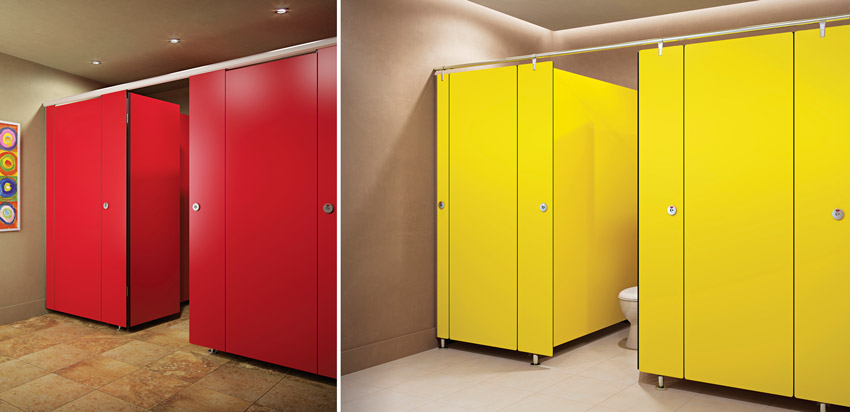
Photos courtesy of ASI Global Partitions
European-style restroom partitions, such as the different types shown here, can provide a more elegant design solution while fostering more positive perceptions among employees about the overall appeal of their workspace.
Conclusion
Anyone engaged in workplace design has undoubtedly experienced the evolving trends that have been discussed in this course. The key for designers is understanding how to acknowledge, analyze, and use those trends for the benefit of better designed workspaces. Doing so can have a direct impact on the people who work in those spaces, whether in a central or remote location. It can also help organizations be more successful and more profitable by enhancing the engagement and productivity of all involved.
References
“What factors drive workplace performance? The 2013 U.S. Workplace Survey.” Gensler. 2013. Web. 11 April 2017. www.gensler.com/design-thinking/research/the-2013-us-workplace-survey-1.
“How Workspace Design Fosters Innovation.” Steelcase. 2013. Web. April 2017. www.steelcase.com/insights/white-papers/how-place-fosters-innovation/11.
“Workplace Trends and Research.” Allsteel. Web. 30 March 2017. cms.allsteeloffice.com/design-resources/workplace-trends.
O’Neill, Dr. Michael and Wymer, Tracy. Implementing Integrated Work to Create a Dynamic Workplace. Knoll Workplace Research, 2010. Web. 14 April 2017. www.knoll.com/document/1352940439707/WP_ImplementingIntegratedWork.pdf.
Pollock, Christopher J. “The New Workplace: Acoustical Planning Provides Effective Environments.” Sound & Communications. 7 Feb. 2014. Web. 4 April 2017. www.soundandcommunications.com/new-workplace/.
Sound Matters. GSA Public Buildings Service. December 2011. Web. 31 March 2017.
Hoskins, Diane. “Focus on Focus.” Gensler. 24 Jan. 2012. Web. 11 April 2017. www.gensleron.com/work/2012/1/24/focus-on-focus.html.
“Workplace Matters.” GSA Public Buildings Service Office of Applied Science. 2006. Web. https://www.gsa.gov/portal/content/103977.
End Notes
1“Leveraging Mobility, Managing Place.” White Paper 4. General Services Administration (GSA Public Buildings Service. June 2010.
2The New Federal Workplace: A Report on the Performance of Six Workplace 20•20 Projects. GSA Public Buildings Service. June 2009. Web. 30 March 2017. www.gsa.gov/portal/content/103975.
Peter J. Arsenault, FAIA, NCARB, LEED AP, is a practicing architect, green building consultant, continuing education presenter, and prolific author engaged nationwide in advancing building performance through better design. www.linkedin.com/in/pjaarch
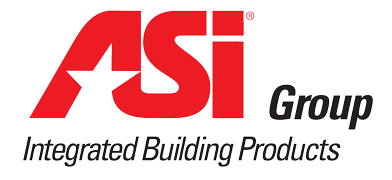
|
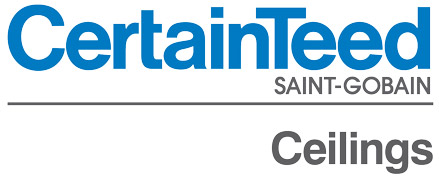
|

|

|

